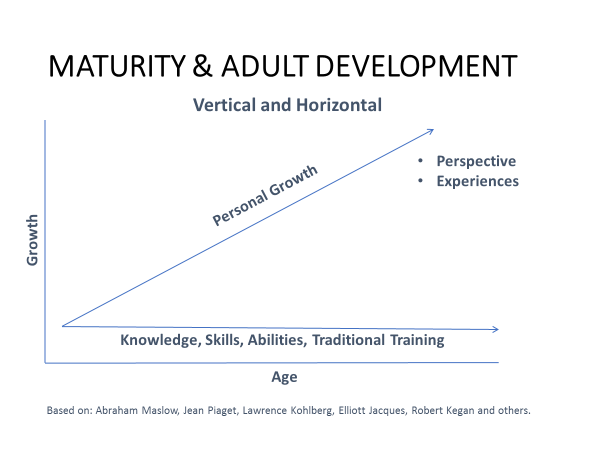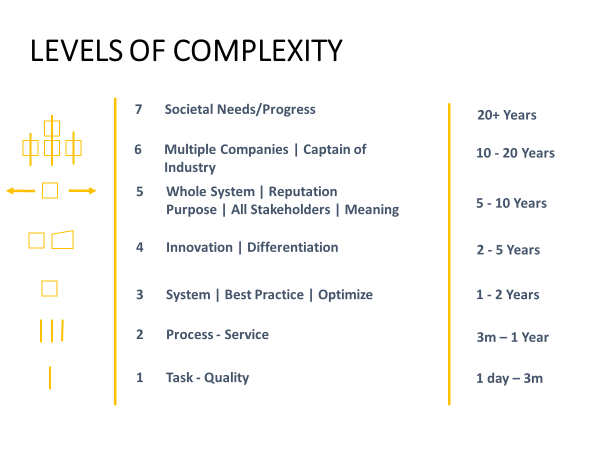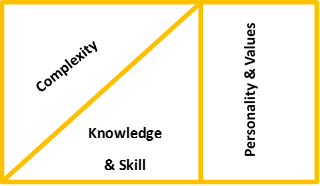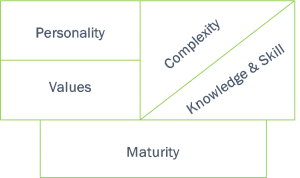This blog post should be read in conjunction with the 3 prior posts – as they build on one another. Visit www.tonyleng.com to review.
All adults grow up, some more quickly than others, and the endpoints are often different. It is important to understand where someone is on their maturity journey, as it is an effective predictor of their effectiveness in the workplace.
Adult development has been studied for years by people such as Jean Piaget, Lawrence Kohlberg and Robert Kegan – and my particular favorite – Keith Eigel, on whose work much of what I say below is based. The basic premise is that adults mature with their cohort, at the same rate, but that the circumstances of life cause some to grow/mature quickly, and others to grow/mature more slowly. It is our experiences, and how we take perspective on those experiences, that drives our maturity growth rate. As I start to talk you through the Maturity levels, think back and see if you can recognize your journey, and how you matured from level to level.
We learn and grow from both positive and negative experiences – at work and in our personal lives. We are whole people who can’t compartmentalize and hope to be authentic. Unfortunately (or fortunately), it is the big personal events that mature us most: those that involve relationships, health, and finance (e.g. death, divorce, sickness, loss of job/money, etc.). While these events are painful, as we walk through the levels of maturity, try and think back to those events as catalysts for your personal growth/maturity. And don’t overlook the positive experiences: promotions, marriage, birth of kids, etc.
Another thing to keep in mind is this: adult growth is a bit like walking through wet cement. It is tough to not get stuck; but if we press on, we move forward. The challenge comes when we stop and the cement sets. At that point we typically need a big “event” to break up the cement and get us moving again.
The diagram below sets up the basic premise:

Maturity Level 1:
This happens from birth until about 8 years old and is not our focus. We pick up the plot at Maturity Level 2 because there are leaders who function at this level.
Maturity Level 2:
At this level, “It’s all about me.” We are typically at ML2 between the ages of 10 and 17, and life is pretty simple. We operate from our own self-interest, are selfish, and work to win – no matter the cost – there is no compromise. We only see things from our perspective, which makes life simple in a “you scratch my back and I’ll scratch yours” sort of way.
ML2 people are motivated by reward and punishment. It is appropriate for a 10-year-old – “If you pass with an A, then you can have a bike.” – but not so suitable for a 40-year-old!
Most people move to ML3 in their late teens after discovering that pursuing their own agenda at all costs limits their success, and they start putting themselves into the other person’s shoes. There are very few leaders who remain at ML2 – sports stars, rock stars, and individuals who inherited Dad’s wealth/business. The rest of us have our selfish instincts knocked out of us by our peer group – which brings us to Maturity Level 3.
Maturity Level 3:
At this level, we are “overwhelmed by outside influences”. This happens from high school through our early working years, where you are basically a portfolio of learned responses and outside inputs from peers, teachers, coaches, professors, bosses, political affiliations, religious/spiritual leaders, social media, etc. Our circumstances determine our well-being and we need to be known, liked, accepted, and included. It is a tough place to be.
What ML3 people stand for is limited by what others will think of them, and they are reliant on outside sources to make sense of a situation or know what to do. They have very high affiliation (to their group), are motivated by connections and acceptance, and unity of their group/team is paramount. They are defined by the roles and relationships they have, circumstances often determine their wellbeing, they seldom take responsibility for mistakes, and tend to blame others.
ML3 is not a great place to lead from, as we are so concerned for the wellbeing of others that we can’t make good business decisions. I interview a lot of people and allow candidates one or two “that is a really good question” statements; but if they say it all the time, I get concerned that they are trying to make me feel good – a typical trait of ML3.
There is an “effectiveness transition” as we move from ML3 to ML4. It is hard to be a leader at ML3, as we are so dependent on our outside influencers that making business-oriented decisions is stressful. This example may help: An ML3 leader who must let someone go finds it tough, as she is constantly worrying about what the person being let go (and others) are thinking because group unity, acceptance, and making sure everyone is “OK” are paramount. So, they tend to blame others; telling the person being let go they were told to do it, etc. They cannot have empathy without owning the other person’s well-being.
ML4 and ML5 are where we become effective leaders and I will unpack those two levels in my next two blog posts.
(Note: If you are enjoying the maturity level discussions, get Keith Eigel’s book, The Map. I borrow most of this from him and he gives tremendous context and depth to the subject.)



